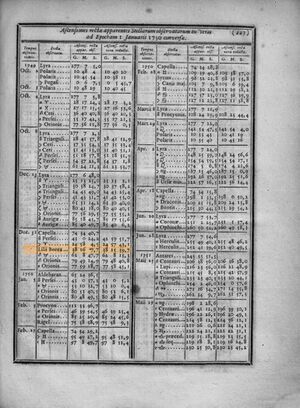Lilii Borea: Difference between revisions
No edit summary |
No edit summary |
||
| Line 51: | Line 51: | ||
In 2017 the IAU WGSN adopted Lacaille’s name Lilii Borea for 39 Arietis, a 4.52 mag-star HR 824 (SIMBAD). They gave 41 Arietis the name Bharani after the second nakshatra (lunar mansion) in Hindu astronomy, consisting of 35, 39, and 41 Arietis. |
In 2017 the IAU WGSN adopted Lacaille’s name Lilii Borea for 39 Arietis, a 4.52 mag-star HR 824 (SIMBAD). They gave 41 Arietis the name Bharani after the second nakshatra (lunar mansion) in Hindu astronomy, consisting of 35, 39, and 41 Arietis. |
||
In 2023/ 24 the IAU WGSN discussed the parallel name. As the identification of ''Lilii Austrina'' with 41 Arietis is without any doubt due to the given coordinates, and this star already has a name given by the IAU already, WGSN refrains from applying "Lilii Austrina". Ian Ridpath withdrew his suggestion. |
|||
The name was applied to the (39 Ari) in the IAU-CSN in 2017. |
|||
== Weblinks == |
== Weblinks == |
||
Revision as of 06:51, 24 July 2024

Ignace-Gaston Pardies introduced a new (now obsolete) constellation , Lilium, the fleur-de-lis of France, in 1674. He had reused four stars in the north of Aries, which were unnamed in Antiquity and subject to various namings in the Early Modern Ages. The individual stars of the Lily were unnamed.
In the Almagest, it is listed as "The 4 stars over the rump [of the Ram]", outside the constellation image.
Etymology and History
Lacaille named its two brightest stars Lilii Borea and Lilii Austrina (i.e. in the north and south of the lily). The Latin term can be interpreted as "a star outside the constellation and in the north/south of it" or "a star in the northern/southern section of the constellation". As both stars form part of the asterism (since Ptolemy where it was unnamed), we should understand "The Northern One of the Lily" and "The Southern One of the Lily".
In his Astronomiæ fundamenta novissimis solis et stellarum observationibus stabilita published in 1757[1], Lacaille presented several tables, e.g. a star catalogue (Tabula exhibens Stellarum a∫cen∫iones rectas veras declinationes veras) and a list of right ascensions of selected stars (De veris aliquot Stellarum afcenfionibus rectis fæpiùs) where he calls the two star names Lilii Borea and Lilii Austrina.
| RA1750 | DEC1750 | identification | |
|---|---|---|---|
| Lilii Borea | 38° 15' 39."7 | 28° 11' 33."1 | 39 Arietis (a star of Lilium) |
| 39 Ari (Stellarium) | 38.°28
38° 17' 1".6 |
28° 11' 34."6 | |
| Lilii Austrina | 38° 49' 45."2 | 26° 12' 47."7 | 41 Arietis (a star of Lilium) |
| 41 Ari (Stellarium) | 38.°84
38° 50' 37" |
26° 12' 52."1 |
Lacaille also published the Ephemerides des mouvemens celestes, pour dix annees, depuis 1765[2] and names these two stars La Boreale a la fleur de Lys (The Northern one of the Lily) and L'Australe a la fleur de Lys (The Southern one of the Lily).
The modern designations of these two stars are 39 and 41 Arietis.
Mythology
The Lily was an emblem of France: the "Fleur-de-lis" (Unicode U+269C ⚜) is a heraldic symbol. In particular, in the time of Louis XIV this symbol was dedicated to the French king as the country's representative.
IAU Working Group Star Names
In 2017 the IAU WGSN adopted Lacaille’s name Lilii Borea for 39 Arietis, a 4.52 mag-star HR 824 (SIMBAD). They gave 41 Arietis the name Bharani after the second nakshatra (lunar mansion) in Hindu astronomy, consisting of 35, 39, and 41 Arietis.
In 2023/ 24 the IAU WGSN discussed the parallel name. As the identification of Lilii Austrina with 41 Arietis is without any doubt due to the given coordinates, and this star already has a name given by the IAU already, WGSN refrains from applying "Lilii Austrina". Ian Ridpath withdrew his suggestion.
Weblinks
- Ridpath, Ian, Star Tales: Lilium, the fleur-de-lis
Reference
- Warner, D. J., (1979) Sky Explored: Celestial Cartography 1500–1800, Alan R. Liss, Inc., New York / Theatrum Orbis Terrum Ltd., Amsterdam, p. 213.
- Kanas. N., (2007) Star Maps: History, Artistry, and Cartography, Praxis, Chichester, p. 159.
- ↑ Lacaille, N. L. (1757). Astronomiae fundamenta novissimis solis et stellarum observationibus stabilita, Lutetiae in Collegio mazarineo et in Africa ad caput Bonae Spei peractis a Nicolao Ludovico de La Caille. Digitalized by GoogleBooks, here p. 227 and 233.
- ↑ Lacaille (1765) Ephemerides des mouvemens celestes, pour dix annees, depuis








